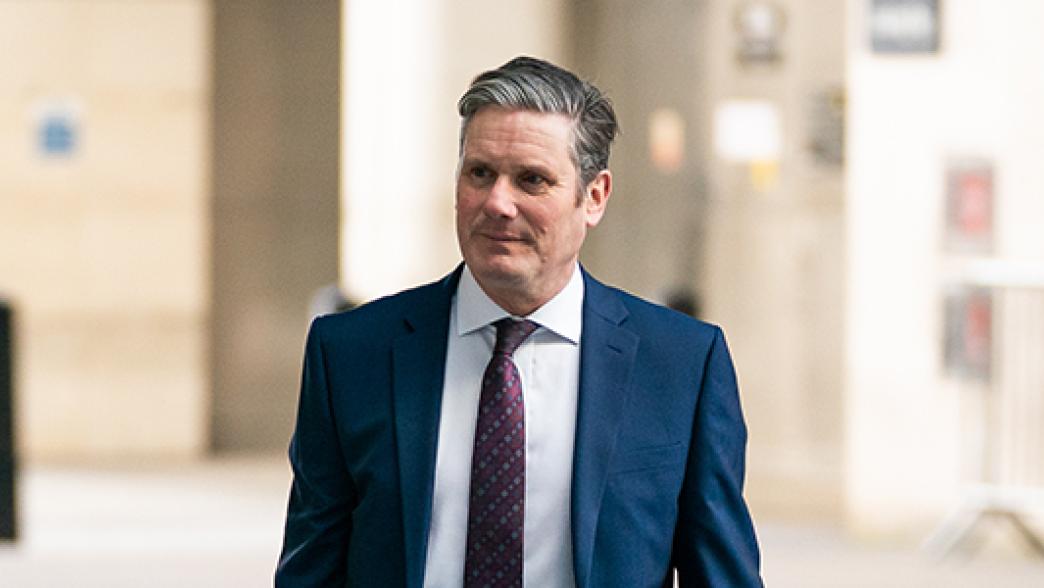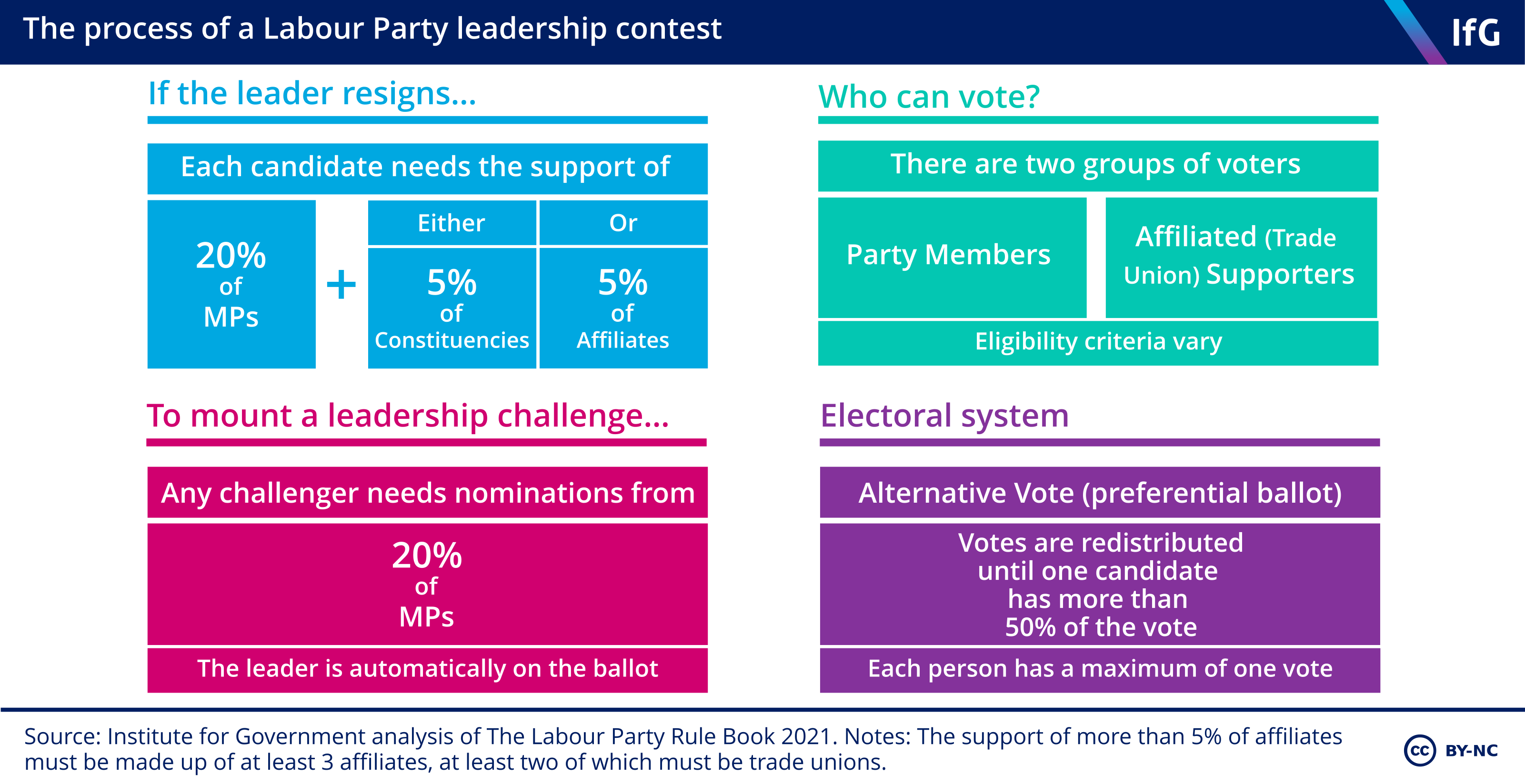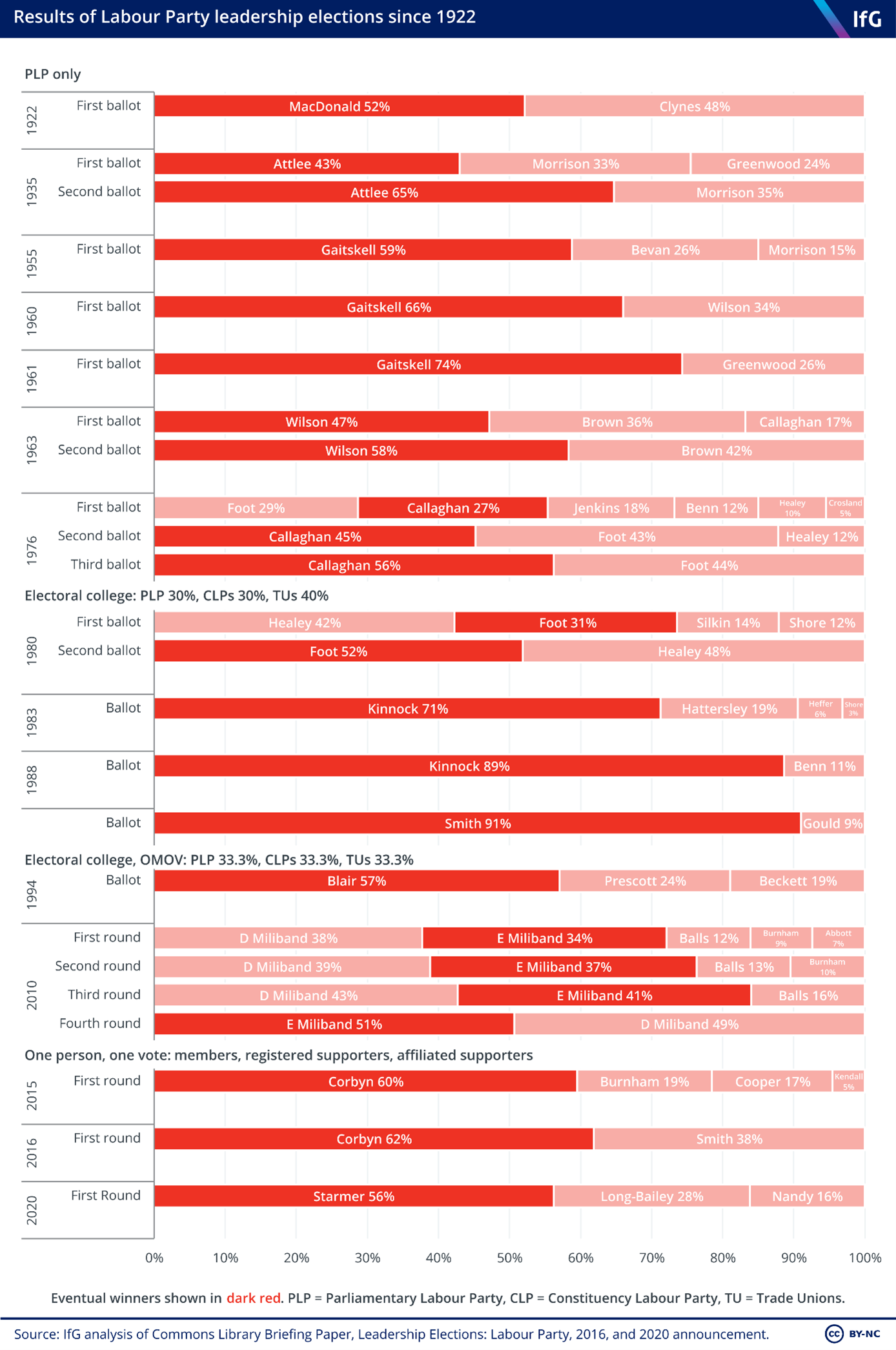Labour Party leadership contests
If the Labour Party leader resigns, then a contest for a new leader is automatically triggered.

What was the result of the 2020 Labour Party leadership and deputy leadership contests?
On 4 April, Sir Keir Starmer became the new leader of the Labour Party. Starmer won the contest in the first round of voting with 56.2% of all first preference votes.
Angela Rayner became the new deputy leader of the party, winning the contest with 52.6% of votes in the third round of voting.
There were three contenders for the Labour leadership in the 2020 election:
- Rebecca Long-Bailey, MP for Salford and Eccles
- Lisa Nandy, MP for Wigan
- Sir Keir Starmer, MP for Holborn and St Pancras
There were five candidates for the deputy leadership:
- Dr Rosena Allin-Khan, MP for Tooting
- Richard Burgon, MP for Leeds East
- Dawn Butler, MP for Brent Central
- Ian Murray, MP for Edinburgh South
- Angela Rayner, MP for Ashton-under-Lyme
In total, 784,151 Labour party affiliates voted in the election. The ballot opened on 21 February and closed at 12pm on 2 April. Due to the coronavirus pandemic, the result was be announced by email on 4 April, rather than at a special conference as originally planned.
What happens if the Labour Party leader resigns the leadership?
If the Labour Party leader resigns, then a contest for a new leader is automatically triggered.
Prior to October 2021, each candidate only needed to be nominated by 10% of the combined ranks of Labour MPs, and until the UK left the EU, MEPs, to gain a place on the ballot. However, the rules were changed during the 2021 Labour Party Conference so that, in future leadership elections, each candidate would need to be nominated by 20% of Labour MPs.[1] A rule change in late 2018 also required candidates to be nominated by at least 5% of constituency parties or at least three affiliates (two of which must be trade unions) which represent a minimum of 5% of the affiliated membership.
Affiliates are groups or organisations which have interests consistent with those of the Labour Party – they include trade unions, co-operative and socialist societies.

How do Labour MPs initiate a leadership challenge against the leader?
There is only one way for Labour MPs to formally initiate a leadership challenge. A challenger (or challengers) must be nominated by at least 20% of the combined ranks of Labour MPs. Nominations must be submitted in written form to the general secretary of the party. This triggers a leadership contest.
In these circumstances, a sitting leader is not required to seek nominations (they are on the ballot paper by default).
Can Labour MPs remove a leader through a vote of no confidence?
Unlike the Conservative Party, there is no formal role for a vote of no confidence as part of the process of a leadership challenge. Although the Parliamentary Labour Party held a no confidence vote in the leader in 2016, Jeremy Corbyn refused to resign and argued that his support among party members outweighed his lack of support from Labour MPs.
What is the voting system used in a Labour leadership election?
The Labour Party has used a one-person-one-vote system for leadership elections since 2015. As both Labour Party members and affiliated trade union supporters are able to vote, this system ensures that the same person cannot vote both as a trade union member and as a Labour Party member. Until October 2021, it was also possible for registered supporters to vote without becoming a full party member. However, this is no longer the case.
Affiliated trade union members have to opt-in to be affiliated supporters of the Labour Party. Members of the Parliamentary Labour Party (PLP) also have one vote each in the leadership election. This means that a large membership can vastly outvote the PLP.
Voting takes place using the alternative vote system (a preferential ballot). If one candidate gets more than 50% of the vote, they are elected. If no candidate manages this, then the candidate who came last is removed and their votes are redistributed to voters’ second preference candidates. This process is repeated until one candidate has more than half of the votes.
When can a Labour leadership election take place in opposition?
The timing of a leadership election is decided by the Labour Party rule book, with exact timings decided by Labour’s National Executive Committee (NEC). The NEC is made up of nominated and elected representatives of the Labour Party’s various groups and affiliates.
When in opposition, election of a leader usually takes place at the annual party conference. While there is no official mechanism to call an emergency conference before an annual conference, the NEC has the power to do so.
If the leader becomes permanently unavailable when in opposition, the deputy leader automatically becomes party leader on a temporary basis until the NEC decides whether to hold an immediate ballot, or wait until the next party conference. The NEC also decides what powers are available for an acting leader to use.
If both the party leader and deputy leader become permanently unavailable, or the post of deputy leader is vacant, the NEC will conduct a postal ballot of Labour Party membership to select a new leader. In the interim period, the NEC may appoint a temporary leader in consultation with the shadow cabinet.
When can a Labour leadership election take place in government?
When in government, an election can only take place if a majority of the party conference request it through a card vote (also known as a block vote). This gives 50% of the voting power to affiliated organisations and 50% to constituency Labour parties.
The only exception to these rules is if the leader becomes ‘permanently unavailable’. The NEC – which is made up of nominated and elected representatives from the Labour Party’s various groupings and affiliate – plays a key role in deciding what happens if a leader becomes permanently unavailable.
Has the election of the Labour Party leader always worked this way?
Under Ed Miliband, who was leader of the Labour Party from 2010-15, the system was changed to the one-person-one-vote system used today. This caused controversy during the 2015 leadership election, when 105,000 people paid £3 to become a registered supporter.
This prompted changes to the registered supporter scheme in 2016. Those who wished to become registered supporters now had to pay £25 and only had a two-day window in which to register.
Another change was an early cut-off for members to be eligible to vote, with party members and trade union members required to have joined their relevant organisations before 12 January 2016 in order to be eligble to vote in September.
These changes remained in place during the most recent leadership contest: people could pay £25 to become registered supporters in a 48-hour window at the beginning of the contest.
However, following a vote at the 2021 Labour Party conference, the party’s rulebook was changed to abolish the registered supporter category. In future leadership contests, only party members and affiliates will be permitted to vote.
How does the deputy leadership contest work?
On 6 November 2019, Tom Watson resigned as deputy leader of the Labour Party. The election of a new deputy leader took place on the same timetable as the 2020 leadership election.
In normal circumstances, the election process for deputy leader works in the same way as the party leader, with the same process of nominations and voting.
However, if the party is in government and the deputy leader becomes permanently unavailable, the Cabinet may consult with the NEC to either appoint a deputy leader or to leave the position vacant until the following party conference. This process for appointing a new deputy leader is also followed if the party leader becomes permanently unavailable and the deputy leader is appointed acting leader, leaving the position vacant.

- Elgot, J, Labour leadership rule changes pass after last-minute Unison backing, The Guardian, 26 September 2021, www.theguardian.com/politics/2021/sep/26/labour-leadership-rule-changes-pass--last-minute-unison-deal-starmer
- Keywords
- Government transparency
- Publisher
- Institute for Government